
Page 25: of Offshore Engineer Magazine (May/Jun 2019)
Offshore Renewables Review
Read this page in Pdf, Flash or Html5 edition of May/Jun 2019 Offshore Engineer Magazine
and lifting capability, up to 270 meters in up to 80 meters wa- ter depth. “The Voltaire will be able to install at unrivalled hub- heights up to 165 meters with the standard boom,” says Manager
Offshore Renewables at Jan de Nul Peter De Pooter. “This will allow the installation of the next generation turbines, with blade tips that might end up as high as 270 meters above the sea level.”
The Voltaire comes on top of Jan de Nul’s offshore jack-up installation vessels, Vole au vent, acquired just four years ago, and Taillevent, which are able to install turbines up to 10MW, says the ? rm. “They can lift all the components up to the ac- tual max hub height of 120 meters,” says Jan de Nul. “The next generation of turbines 10MW+ will become a challenge for all installation vessels currently available on the market,” De Pooter. “Foundations will be heavier; blades will be longer. The size, weight and heights will limit the quantity of tur- bines that can be transported per cycle [on board of today’s in- stallation ? eet] to one or maximum two. A vessel with the appro- priate technical characteristics is the answer to this challenge.”
De Pooter sees a wider market for this vessel. “Offshore wind outside Europe and China is starting to develop,” he says. “Tai-
Source: Jan De Nul wan is working on its ? rst full scale wind farms and Jan De Nul “THE NEXT GENERATION OF TURBINES
Group is one of the main contractors for the two ? rst engineer- +10MW WILL BECOME A CHALLENGE ing, procurement and construction (EPC) contracts: the 120MW
FOR ALL INSTALLATION VESSELS
Formosa 1 wind farm in 2019 and the 110MW Changhua wind
CURRENTLY AVAILABLE ON THE MARKET,” ... farm in 2020. Both wind farms are currently under construction.” “FOUNDATIONS WILL BE HEAVIER; BLADES
UK-based Seajacks has been operating in the offshore
WILL BE LONGER. THE SIZE, WEIGHT AND wind business since 2006. Since then, it’s built the Kraken,
HEIGHTS WILL LIMIT THE QUANTITY OF
Leviathan, Hydra, Zaratan and, most recently, Scylla jack-
TURBINES THAT CAN BE TRANSPORTED ups. Seajacks expects to see the next generation turbines, eg.
PER CYCLE [ON BOARD OF TODAY’S 12MW and, in number from 2023-25 and it is in discussion
INSTALLATION FLEET] TO ONE OR MAXIMUM with developers over installing 12 or 15MW units with Scylla,
TWO. A VESSEL WITH THE APPROPRIATE which entered service in 2016 and has a 1,500-metric-ton leg-
TECHNICAL CHARACTERISTICS IS THE encircling crane and can work in up to 65 meters water depth.
ANSWER TO THIS CHALLENGE.” “We think there is still a good number of vessels in the market that can install the larger wind turns, [dependent on site char- – PETER DE POOTER, acteristics], when they arrive in the market. However, to install
MANAGER OFFSHORE RENEWABLES, 10-15MW turbines, many of the current units will need to be
JAN DE NUL upgraded and modi? ed in order to stay relevant,” says Max
Paterson, commercial manager at Seajacks. “The main issues for older smaller vessels in the market will be hook heights for nacelles and variable deck load, to carry heavier and larger ber of turbines will be required to reach a wind farm’s genera- components, and deck space. This means new cranes and leg tion capacity, likely resulting in fewer utilization days for ves- extensions, etc., and it is likely that these necessary upgrades sel owners,” Paterson says. “It is already a challenge keeping will have a negative effect on how fast these vessels can install.” vessels occupied all year round.”
Having said that, Paterson also thinks demand and supply “We already have an extremely competitive WTIV supply should be well balanced. “The market might become tight in chain,” he adds, “with a lot of cost-effective equipment in the some years, in the peak installation months over summer, if market. Will it make sense to move the turbines weights and multiple projects are planned over the same time,” he says. Con- dimensions to a level where only two or three vessels are suit- versely, ensuring vessel utilization is also key for owners, which able? Only time will tell, but with the ferocious focus on low- is why Paterson expects WTIV vessels will need to work around ering cost, particularly on installation, I am sure developers the world in the various new markets, like Asia and the US. and turbine manufacturers will be very mindful of supply and “Larger turbines, e.g. 10-15MW, will mean a smaller num- demand dynamics in the WTIV market.”
MaY/JUNE 2019 OFFSHORE ENGINEER 25

 24
24

 26
26